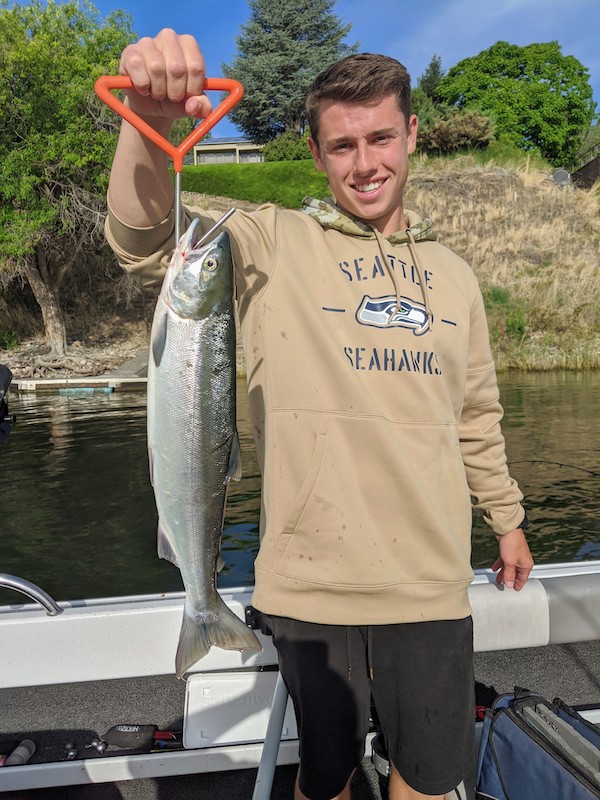
Sockeye Skyrocket; 2nd Largest Day Ever At Bonneville Sunday
Update, 2:45 p.m., June 27, 2022: WDFW’s Paul Hoffarth reports that the Technical Advisory Committee for Columbia fish runs has updated this year’s sockeye forecast to 426,000 back to the mouth of the big river, more than twice as many as were expected in the preseason. Summer Chinook expectations have also been raised, from 56,300 to 66,800.
There’s just something about June 26 at Bonneville when it comes to sockeye.
Yesterday saw the second highest daily count ever at the lowest Columbia River dam, 40,584 – a figure that is just 1,000 fish shy of the all-time high mark set 10 years ago that same day and 10,000 more than what is now the 11th largest day on record, also a June 26.

Of course this is the time of year that the sockeye run traditionally peaks – June 26 marks the highest average over the past 10 years – but what is notable is how high the run has jumped in so short a period of time – and how high it might still go.
Whether it keeps climbing is hard to say, but in skyrocketing to such stratospheric heights, yesterday also obliterated the forecast of 198,700 of the salmon this season. So far 239,575 have been counted at Bonneville.
Based on the preseason prediction, sockeye retention is currently closed from the mouth of the big river up to Pasco, but anglers have been keeping a few so far in the Hanford Reach. WDFW’s Paul Hoffarth last Monday reported 27 sockeye for 44 boats and four bank anglers from June 16-19.
WDFW’s Ryan Lothrop this morning said that the Technical Advisory Committee has scheduled a meeting today to look at how the Columbia’s summer runs are progressing, both Chinook and sockeye.
“Positive signs all around!” said Washington’s sport and commercial manager for the system.
Indeed, this year’s above-Bonneville-bound spring Chinook run far exceeded expectations, with 173,701 counted at the dam through June 15, the end of the run’s management period. The preseason forecast was for 122,900, and as springers continued to run up the tally, state managers were able to extend fishing. Ocean conditions have turned beneficial in recent years.

The lion’s share of this year’s sockeye run is heading to the Upper Columbia, primarily the Okanogan/Okanagan River and the Wenatchee River and Lake Wenatchee, but a relative handful will peel off at Tri-Cities and follow the trail of their forebearer Lonesome Larry up the Snake to Central Idaho.
Even if Lower Columbia plunkers will have missed out on the run, those in the upper river at places like the Hanford Reach, Wells Dam and the Brewster Pool should enjoy good fishing, or at least a lot of sockeye to try and catch.
A quick review of big sockeye days at Bonneville shows that most cluster from June 21 to the 27, but early July 2014 did see some fireworks with a pair of 34,000-plus-fish days.
Here are the top 10 counts by day in order:
- 41,573, June 26, 2012
- 40,584, June 26, 2022
- 38,756, June 25, 2012
- 34,549, July 5, 2014
- 34,253, July 4, 2014
- 32,047, June 25, 2022
- 31,969, June 27, 2012
- 31,880, June 22, 2015
- 30,690, June 24, 2010
- 30,374, June 23, 2010
- 30,262, June 26, 2014
Those hot July days helped 2014 power to the highest single-year sockeye count at Bonneville in records that go back to 1938 and its construction:
- 614,179, 2014
- 515,673, 2012
- 510,706, 2015*
- 386,525, 2010
- 342,498, 2016
There’s an asterisk on 2015 because that year also saw a large dieoff of the run between Bonneville and McNary due to overheated, low waters in the mainstem as a poor snowpack and hot early July temperatures combined to punish sockeye as well as sturgeon.
True, the past few days and today are hot across the region, but thanks to our extended wintery spring the Columbia is flowing higher and colder than average over the past five years. WDFW last Monday reported it was rolling along at 438,000 cubic feet per second and 57 degrees. Averages are 246,000 cfs and 61.
This year’s big flush should also help more smolts reach the ocean.
Correction: 6:12 a.m., June 28, 2022: The June 26, 2014 sockeye count of 30,262 at Bonneville Dam was misreported as the 10th largest day on record. As of yesterday it was the 11th. The editor forgot that June 25, 2022 saw 32,047 fish go through, bumping June 26, 2014 down a peg.

